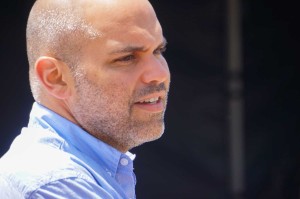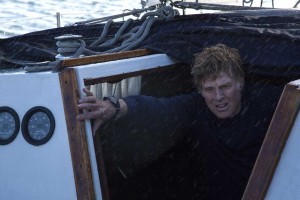
With the intense character study, All is Lost, editor Pete Beaudreau continued the creative collaboration he began with director J.C. Chandor on his award-winning first film, Margin Call.
All is Lost focuses on a man’s struggle with mortality when his sailboat sinks in a storm. With virtually no dialog, the drama hinges on the physically challenging and emotionally complex performance by Robert Redford. “J.C. had this really smart idea early on where he wanted the camera to always be, essentially, like-bungee-corded to Bob, so we would never get that far away from him. We’d always be anywhere from three feet to ten feet. That was kinda our cut off,” explained Beaudreau. “There are only a few spots in the film where we break that rule and really get some distance from him.”
On dialog films an editor spends the day with human voices. Beaudreau revealed that having no dialog was surprisingly lonely. During the first assembly of the scenes, Beaudreau shut off the production sound – which was totally replaced in post – and cut purely for the visual and story beats. He felt the sound was slowing him down, making it difficult to keep up with the pace of the shoot. “I never cut that way before. It turned into an interesting workflow that I’ve applied to dialog films that I’ve worked on since then,” said Beaudreau. “By taking sound out of the equation all together, you are totally locked in on performance. And Bob’s eyes. The expression on his face. He’s an incredibly internal actor. He can display thought process pretty much like no one else.”

The film was shot in three real boats at multiple locations – interior and exterior tanks, the open ocean, but never docked on dry land. The cramped quarters of the sailboat affected coverage and editing decisions, while informing visual choices for the story. Beaudreau refined a cutting style that used a combination of jump cuts and time jumps to carve out the best moments in the story. “A lot of the film is covered in long takes. It’s a matter of distilling the action down to the most integral components. That’s how we came up with the rhythm of the edit,” shared Beaudreau. “It really let us control the pacing in a way that we wouldn’t have the ability to do if we were with a bunch of actors and dialog. That lent itself to an immediacy. The film, when it is at its most successful, is a documentary. It feels like you are on the boat with him and you are him.”
The use of jump cuts and time jumps contributed to that authentic documentary feel. “The footage always tells you how it needs to be cut,” shares Beaudreau. “I can’t imagine using these time cuts in any other film. It’s story specific,”
The editing room was in an Avid-equipped dressing room about “thirty-seconds” from set. Dailies shot in Mexico were processed in Los Angeles with a three-day turnaround, so Beaudreau started editing off a feed from the video assist. Everything shot in the morning was loaded during lunch and edited in the afternoon. At the end of the day, the director would view the film and they would decide if other shots were needed. Beaudreau kept a wish list, “We essentially worked that way through the entire shoot. It was the first time I had ever been on set, which is stressful and an entirely different process than being in an editing room that is far away where you are just secluded by yourself.”
Working on set, Beaudreau developed an especially close working relationship with script supervisor and associate producer Erin Feeley. “I finally figured out what they do,” Beaudreau laughed. “We spent so much time in my office going through coverage to come up with the extensive lists of what we needed.”
Except for holes that needed to be filled, for the most part, the company shot sequentially, which supported building the character arc over the course of the shoot, resulting in a powerful performance and engaging film experience.





